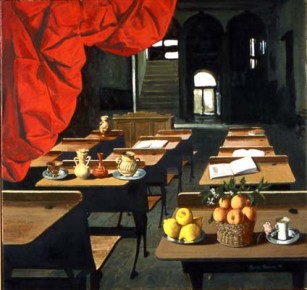Related Works
|
| WorkSpanish School, The
| Image Notes
Original Title: Black Shadow School. See Artist's Note.
| Artist's Notes
When I was a student I learned about a tradition in Spanish painting of making very dark ink-solid shadows, a Black Shadow school of painting. You see it in Zurbaran and Ribera and Velazquez and Goya. When I was in Spain I saw how naturally this is an expressive response to the unsparing Spanish light that turns even the sky dark. Things are very different in Italy where shadows are gray and light-filled and where the light is seen to turn corners. In Tuscany and Umbria you look at an arm or a tree trunk that is in light and you notice that the light reflects around the cylindrical form. You see this softly rounding light in Piero and Perugino and Raphael. But in Spanish light these forms look like a basic drawing, bright on one side, black on the other. As i was working, "Black Shadow" was the title I had in mind for the painting that became The Spanish School. I conceived of a long dark tunnel that I would put the school desks on the floor of, and then I would turn a beam of light on the desks from the left, like a spotlight that would cause them to erupt out of the darkness. While I was working this out in a preparatory drawing I came upon a painting by Zurbaran in which he paints a red curtain up front on the surface of his canvas, a theatrical red exclamation that effectively hides the source of light in his painting. I decided to quote Zurbaran's red curtain, moving it from the right side of the canvas, where Zurbaran had it, to the left side of my canvas, where I locate the light source in my painting. This was when my painting began to look Spanish. I was looking at a lot of Spanish paintings when out of nowhere it occurred to me that Sargent's Venetian Bead Stringers would provide the perfect Spanish atmosphere for the back wall of my dark tunnel of space. I tried it and it did. The glare of light through the openings in that far wall are like outdoor light seen from inside a Spanish interior. It is not so much that the windows let in light; rather, they reveal the darkness within. In my study for the painting I had placed Zurbaran's trussed goat on one of the desks. I had one of Zurbaran's cowled monks kneeling in one aisle between the desks and Goya's woman with a water jug standing four-square in another aisle. These figures disappeared as I worked on the painting. The Spanish School is a place filled with the silence of things. I have books on my school desks, and still lifes by Zurbaran: lemons and oranges, cups and pottery. The pottery jug on the desk in front of the teacher's desk is a quotation of the jug in Velazquez's Waterseller of Seville. Between the teacher's desk and the stairway the L-shaped shaft of light suggests the possibility of an entrance from the left and indicates how far away the stairs and the back wall are. There is a blackboard on the wall behind the teacher's desk, so far away that it would be a long walk for teacher or student to get to it and it is probably little used. The school desks occupy only a part of this enormous dark hall. You have to travel a long distance to get to your place in this school room, entering perhaps by descending the stairs, walking past the teacher's desk to find your own, turning and sitting down to face the way by which you came. This place was not made for use as a school and there is consequently a discomfort and a clumsiness that I associate with my experiences of the way space is organized and used in Spain. (George Deem, New York, June 22nd 1999).
| ExhibitionsCapricorn Galleries, Bethesda, Maryland |
Works
| WorkSpanish School, The
| Image Notes| Artist's Notes| Exhibitions |

